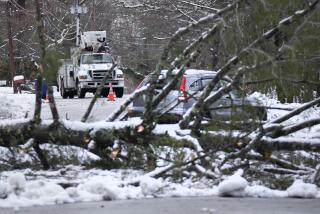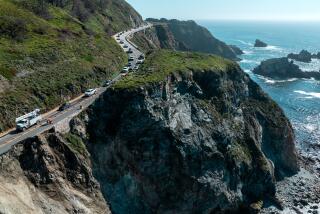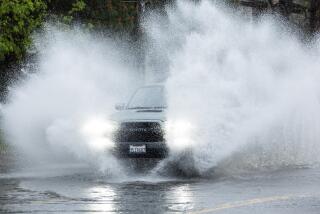Nor’easter threatens areas hit hard by Superstorm Sandy
NEW YORK — A nor’easter that threatens to lash the mid-Atlantic states with freezing rain, snow and high winds appeared to be weakening in the Atlantic Ocean, but still could cause new flooding and power outages and hamper recovery efforts in areas that suffered the brunt of Superstorm Sandy last week.
The new storm is far smaller than Sandy, but officials fear low-lying areas in New Jersey and southern New York are vulnerable because Sandy destroyed so many sand dunes and other natural barriers, as well as man-made sea walls and jetties, that normally limit damage from high storm surges.
Officials said the new storm could cause a tidal surge of 2 to 41/2 feet when it peaks Wednesday night, enough to cause fresh flooding.
The National Weather Service said late Tuesday that the storm was moving farther offshore, lessening its likely impact, but “will definitely be a heavy rain and gusty wind producer while churning up the seas.”
Brick Township in New Jersey issued a mandatory evacuation, ordering residents along its waterfront to leave for shelters and higher ground. Other parts of the town were strongly encouraged to seek shelter. About 30% of Brick Township is still without electricity from Sandy.
“Moderate flooding under normal conditions becomes major flooding under other conditions,” New Jersey Gov. Chris Christie told reporters.
In anticipation of the storm, airlines canceled at least 241 flights scheduled for Wednesday, mostly in and out of Newark Liberty International Airport in New Jersey, and La Guardia and John F. Kennedy International airports in New York.
Like Sandy, the latest storm will strike at the nation’s busiest airspace, disrupting air travel across the country. By canceling flights before the storm, industry experts say, airlines can move planes out of harm’s way, but that leaves passengers stranded or on much-delayed flights.
Christie said utility crews working to restore power would be slowed by the storm because they couldn’t operate some equipment in winds greater than 40 mph.
Across the region, more than 930,000 people remained without electricity Tuesday afternoon, according to the Department of Energy. With overnight temperatures expected to drop into the 30s, and tens of thousands of people without heat or adequate housing, government agencies and relief groups raced to bring more supplies to hard-hit areas of New York’s outer boroughs and New Jersey.
Some of the hardest-hit seaside towns — Staten Island’s Midland Beach and South Beach and Brooklyn’s Howard, Gerritsen, Sea Gate and Brighton beaches — will probably be without power past the weekend because of structural damage to Con Edison electrical equipment, said spokesman John Miksad.
On a visit to Long Island, Homeland Security Secretary Janet Napolitano said local, state and federal agencies had made “a lot of progress” in providing food, water, fuel and emergency housing to storm victims. But she cautioned that the nor’easter could complicate relief and recovery operations.
“I urge everyone to closely follow the developing weather conditions and continue to listen to the guidance and direction of their state and local officials,” Napolitano said.
New York City did not order residents to evacuate, but officials planned to close parks, playgrounds and beaches for 24 hours at noon Wednesday to protect people from falling trees and high surf.
“We could have some snow on the ground and certainly snow on the trees,” Mayor Michael R. Bloomberg said. “That makes the trees that already have their bases flooded more likely to fall over.”
President Obama and top federal disaster officials discussed housing needs during a morning conference call. So far, 263,000 people have applied for help to the Federal Emergency Management Agency, which has approved more than $240 million in direct assistance, the White House said.
In an effort to speed removal of storm debris, New York Gov. Andrew Cuomo declared the wreckage in nine counties a public health hazard and ordered agencies to get rid of it immediately.
New York officials also launched an investigation into alleged price gouging after receiving hundreds of complaints from consumers who said they were forced to pay exorbitant amounts for gasoline, food, generators, batteries, hotel rooms and other necessities after Sandy hit.
“Our office has zero tolerance for price gouging,” said New York Atty. Gen. Eric Schneiderman.
Times staff writers Tiffany Hsu, Hugo Martin and Michael Muskal in Los Angeles contributed to this report.
More to Read
Start your day right
Sign up for Essential California for news, features and recommendations from the L.A. Times and beyond in your inbox six days a week.
You may occasionally receive promotional content from the Los Angeles Times.







